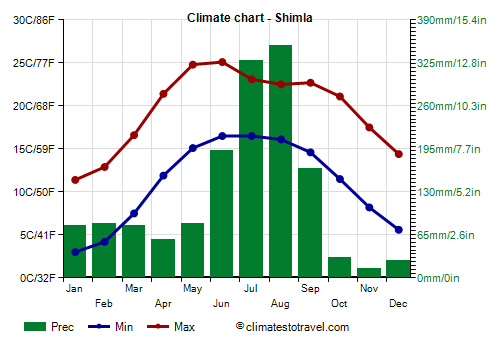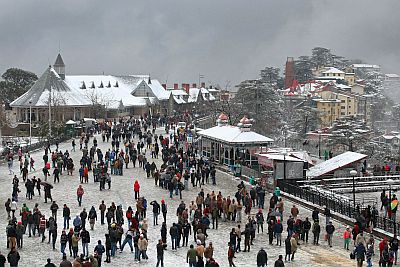Select units of measurement for the temperature and rainfall tables (metric or imperial).
Average weather, temperature, rainfall, sunshine hours

In Shimla (or Simla) there is a
humid temperate climate, with a relatively cold winter, a mild, rainy summer, influenced by the Indian monsoon, and a cool, dry autumn.
The city is located in northern India, at 31 degrees north latitude, and is nestled on hills, at an average altitude of 2,200 meters (7,200 feet), in the state of Himachal Pradesh, of which it is the summer capital. In the past, it was the summer capital of British India as well.
The perpetually snow-capped peaks of the Himalayas, which exceed 4,500 meters (14,700 ft), are located about 65 km (40 mi) to the north, while about 40 km (25 mi) to the south-east, there are mountains that reach 3,500 meters (11,500 ft).
 Winter
Winter, from December to February, is quite cold. There are mild periods, more likely in December and February, but also cold periods, in which the night temperature can drop to around 0 °C (32 °F). December is generally a dry month, while in January and February there are periods of bad weather.
Sometimes it can even
snow, generally from December to early March. On average, one meter (40 in) of snow falls per year, most of it in January and February.
On colder nights, the temperature typically drops to -2 °C (28.5 °F), but can occasionally drop lower. In January 1945 it fell to -10.6 °C (12.9 °F), and in February 1972 to -8.5 °C (16.7 °F), although these values are becoming less and less likely with climate warming.
Spring, from March to May, is gradually milder, but it is also quite rainy, especially in March, due to the clash between air masses, and in May, when the Indian continental mass heats up and thunderstorms increase.
On good weather days, from mid-April to the end of May, it can get hot, especially in May, when the temperature can exceed 30 °C (86 °F). At the end of May 2010, it reached 32.4 °C (90.3 °F).
The
summer, from June to September, is quite warm, with daily averages around 20 °C (68 °F). However, it is also a rainy season.
June is the hottest month, and the temperature can reach 28/30 °C (82/86 °F). In this month, thunderstorms often break out, which can also be strong.
The
monsoon in this area runs from late June to late September. July and August are the rainiest months. Fog often forms during this period. Sometimes the rains can be particularly intense, to the point of causing landslides and floods.
Autumn, in October and November, is the driest and sunniest season, with initially mild and gradually cooler weather.
Best Time
The best time to visit Shimla is
autumn, in October and November, as it is the driest of the year. It can get cold at night, especially in November, but not as cold as in winter.
Otherwise you can choose spring, in particular the month of April, which is the driest of this season.
In winter, December is generally preferable to the following months because it is drier.
Shimla - Climate data
In Shimla, the
average temperature of the coldest month (January) is of
7.2 °C, that of the warmest month (June) is of
20.8 °C. Here are the average temperatures.
Shimla - Average temperatures (1991-2020) |
| Month | Min | Max | Mean |
|---|
| January | 3 | 11.4 | 7.2 |
|---|
| February | 4.2 | 12.9 | 8.6 |
|---|
| March | 7.5 | 16.6 | 12 |
|---|
| April | 11.9 | 21.4 | 16.6 |
|---|
| May | 15.1 | 24.8 | 20 |
|---|
| June | 16.5 | 25.1 | 20.8 |
|---|
| July | 16.5 | 23.1 | 19.8 |
|---|
| August | 16.1 | 22.5 | 19.3 |
|---|
| September | 14.6 | 22.7 | 18.6 |
|---|
| October | 11.5 | 21.1 | 16.3 |
|---|
| November | 8.2 | 17.5 | 12.8 |
|---|
| December | 5.6 | 14.4 | 10 |
|---|
| Year | 10.9 | 19.5 | 15.15 |
|---|
amounts to
1485 millimeters per year: it is therefore quite abundant. It ranges from
13.6 millimeters in the driest month (November) to
351.3 millimeters in the wettest one (August). Here is the average precipitation.
Shimla - Average precipitation| Month | Days |
|---|
| January | 80 | 5 |
|---|
| February | 83 | 6 |
|---|
| March | 79 | 6 |
|---|
| April | 58 | 4 |
|---|
| May | 82 | 7 |
|---|
| June | 192 | 10 |
|---|
| July | 328 | 16 |
|---|
| August | 351 | 16 |
|---|
| September | 164 | 8 |
|---|
| October | 30 | 2 |
|---|
| November | 14 | 1 |
|---|
| December | 26 | 2 |
|---|
| Year | 1485 | 84 |
|---|